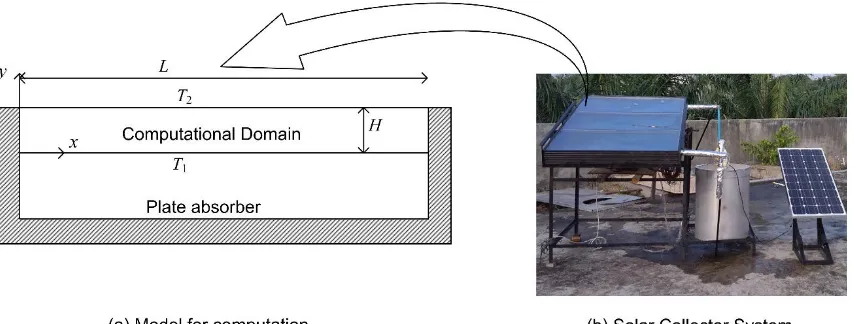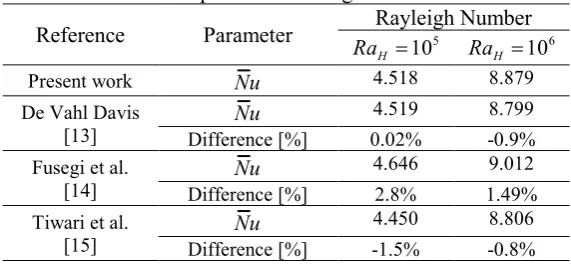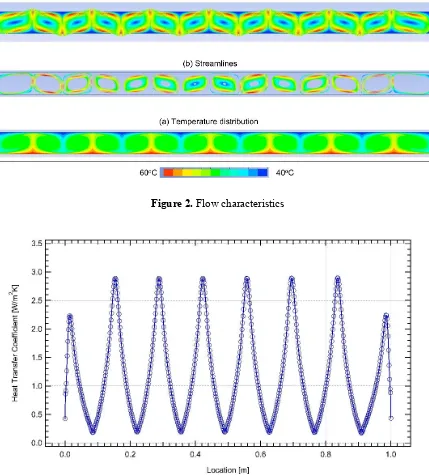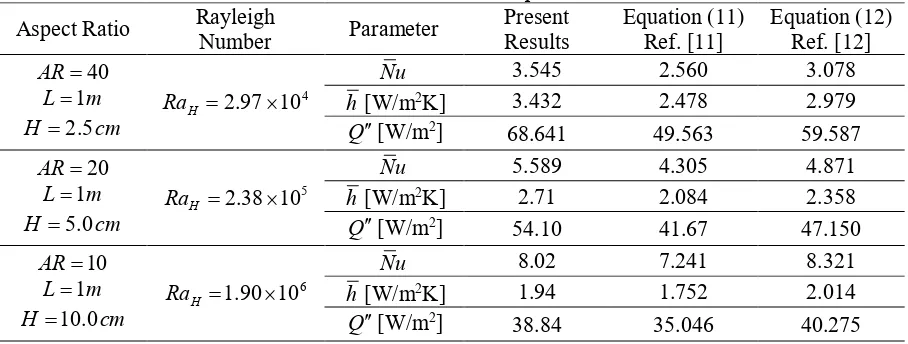IOP Conference Series: Materials Science and Engineering
PAPER • OPEN ACCESS
Numerical study on natural convection between
double glasses top cover of a flat plate solar
collector
To cite this article: H Ambarita 2018 IOP Conf. Ser.: Mater. Sci. Eng.309 012005
View the article online for updates and enhancements.
Related content
Numerical Simulation of a Solar Domestic Hot Water System
L Mongibello, N Bianco, M Di Somma et al.
-Numerical Study on Radiation Effects to Evaporator in Natural Vacuum Solar Desalination System
R E T. Siregar, A D. Ronowikarto, E Y Setyawan et al.
-Numerical study on the effect of configuration of a simple box solar cooker for boiling water
H Ambarita
1234567890‘’“”
TALENTA-CEST 2017 IOP Publishing
IOP Conf. Series: Materials Science and Engineering 309 (2018) 012005 doi:10.1088/1757-899X/309/1/012005
Numerical study on natural convection between double glasses
top cover of a flat plate solar collector
H Ambarita1
1Sustainable Energy and Biomaterial Centre of Excellent, Universitas Sumatera Utara,
Jl. Almamater Kampus USU, Medan 20155, Indonesia
*Email: [email protected]
Abstract. Double glasses cover typically used to decrease top heat loss of a flat plate solar collector. However, reported studies show that the top heat loss of a flat plate solar collector is very significant in comparison with other losses. The present work deals with a numerical study on natural convection between double glasses cover of flat plate solar collector. The main objectives are to investigate the heat transfer characteristics of the covers and to propose heat transfer coefficient correlation. Two-dimensional governing equations and boundary conditions are developed. The governing equations are discretized into linear equation system based on finite volume method. The effects of the aspect ratio (AR) and Rayleigh number are explored and fluid flow in the enclosure are plotted. The results show that AR affects fluid flow and heat transfer characteristics significantly. A correlation proposed by the previous researcher is recommended to calculate top heat loss.
1. Introduction
The world population has increased significantly. It is approximated that the present world population is 7.5 billion people. In the last two decades, the population increased more than 1.5 billion. To support the people activities, the world's energy demand also increasing significantly. Preventing an energy crisis is one of the most casual issues of the 21st century. Solar energy, among other renewable energy sources, is a promising and freely available energy source for managing long-term issues in the energy crisis. The solar industry is developing steadily all over the world because of high demand for energy, on the other hand, major energy source, fossil fuel, is limited and other sources are expensive [1]. Solar energy thermal can be used to power solar desalination [2], adsorption refrigeration [3], solar water heater [4], drying process [5], etc. One of the key components of solar collector system is the collector it'self. Many types of solar collector can be found in literature, and flat-plate type solar collector is the simplest solar collector, and it is very popular [6].
2
1234567890‘’“”
TALENTA-CEST 2017 IOP Publishing
IOP Conf. Series: Materials Science and Engineering 309 (2018) 012005 doi:10.1088/1757-899X/309/1/012005
values of convective heat transfer coefficient and top loss coefficient for rectangular enclosure are lower by 31-35% and 7 %, respectively.
Recently, Computational Fluid Dynamic (CFD) commercial code has been employed to optimize the design of a flat-plate type solar collector. Martinopoulos et al. [10] investigated the behavior of a polymer solar collector experimentally and numerically. Solar irradiation, as well as convection and heat transfer in the circulating fluid and between the parts of the collectors, is considered in the model. Selmi et al. [11] employed CFD commercial code to simulate heat transfer process in a flat-plate type solar collector. The above-reviewed studies show that heat transfer analysis in the enclosure of double glass cover plays an important role in designing and developing a high-performance flat-plate type solar collector. In fact, only a few of empirical correlations are available in the literature. This paper focuses on numerical analysis in the enclosure between double glass cover of a solar collector. The objective is to explore the heat transfer and flow characteristics in the enclosure. The numerical results will be compared with empirical correlation. The results are expected to support the necessary information in developing high-performance flat-plate type solar collector.
2. Method
Our research group in Sustainable Energy and Biomaterial Centre of Excellent, Faculty of Engineering Universitas Sumatera Utara is developing high-performance flat-plate solar collector for several applications such as drying, adsorption cycle, solar desalination, and solar water heater. These applications use flat-plate type solar collector. Typical of the flat-plate type solar collector is shown in Figure 1. In the figure, photograph of a solar water heater that is also shown. The focus of the present study is the enclosure in the top cover of the solar collector.
2.1 Numerical Method
In this study, only the enclosure between the upper and bottom glasses is taken account into consideration. The computational domain is shown in Figure 1(a).
Figure 1. Computational domain and photograph of a system
In this analysis, the domain is assumed to be the two-dimensional case. The flow in the domain is incompressible laminar flow and steady state. The additional assumptions are, there is no viscous dissipation, the gravity acts in the vertical direction, and fluid properties are constant except in density of the fluid. The Boussinesq approximation is used to model the buoyancy force. By using the above assumptions, the governing equations are as follows.
0 u v x y
1234567890‘’“”
TALENTA-CEST 2017 IOP Publishing
IOP Conf. Series: Materials Science and Engineering 309 (2018) 012005 doi:10.1088/1757-899X/309/1/012005
dimensional parameters are stated in the followings.3
Where Pr is Prandtl number and calculated by
Pr
(6)
Convective heat transfer coefficient (h) is calculated using the non-dimensional Nusselt number. It is given by between the double glasses. The Nusselt number is presented using local and average Nusselt number. The local Nusselt number in the bottom and top surfaces are given by
1 2
0, respectively. The average Nusselt number is calculated by
0 commercial code of ANSYS FLUENT is used to carry out the simulation.
2.2 Empirical correlation
The results from simulation will be compared with the analytical results. In the analytical one, the below empirical correlation will be used. There several empirical correlations are found in the literature. The first one is given by Jacob [11].
0.25
In the more recent experimental study using air inside the enclosure, Holland et al. [12] proposed an empirical correlation between the average Nusselt number and Rayleigh number. The equation is given by the following equation.
4
1234567890‘’“”
TALENTA-CEST 2017 IOP Publishing
IOP Conf. Series: Materials Science and Engineering 309 (2018) 012005 doi:10.1088/1757-899X/309/1/012005
This equation is claimed to be valid for tilt angle from 0o to 75o. In the equation the meaning of the
“+” exponent is that only positive values of the terms in the square bracket are to be used and if the value is negative, the value will be converted into zero. The additional condition for using equation (12) is the aspect ration (AR) and the Rayleigh number must be AR12 and 5
10 H
Ra .
3. Results and Discussions
3.1. Numerical Validation
The present numerical method is validated by comparing the result with previously reported studies. The selected numerical validation case is a laminar natural convection heat transfer from a square cavity heated and cooled from side walls, respectively and insulated from the top and bottom walls. The results are compared for Rayleigh number 105 and 106. Table 1 shows the numerical validation of the present result. Data of the table reveals that the present results show a very good agreement with the previous results. Thus, the present method can be used to explore the problem.
Table 1. Comparison of averaged Nusselt number
Reference Parameter Rayleigh Number 5
10
3.2. Flow characteristics and heat transfer
Figure 2 shows flow characteristics of the fluid inside the enclosure. The AR of the presented enclosure is 20. In the figure temperature distribution, streamlines, and velocity vector are shown in Figure 2a, 2b, and 2c, respectively. It is shown clearly that inside the enclosure several circulation flows are generated. This circulation flow is known as "Benard cell". The mechanism can be explained as follows. The heated fluid flows upward, and before reaching the top surface, it is divided into two flows. Each flow will generate a circulation flow. This circulation will be repeated. The streamlines (Figure 2b) clearly show the number of the Bernard cell. In this case, there are 14 Benard cells generated in the enclosure. The same pattern also is shown by velocity vector. The velocity of the fluid will follow the Benard cells.
Locally heat transfer coefficient on the bottom surface is calculated and plotted in Figure 3. The horizontal axis is the distance from the left edge. As a note, the dimension of the present enclosure is 1 m5 cm. The figure shows that, as expected, locally heat transfer coefficient is strongly affected by Benard cells. The Benard cells divided the bottom surface into several dead zones, where the velocity almost zero or stagnant. Between two dead zones, the velocity increases and make temperature gradient higher. Heat transfer coefficient in the dead zone will decrease because temperature gradient is very low. On the other hand, the area between dead zones the local heat transfer coefficient increases and reaching a maximum value. This is because temperature gradient is higher. This fact is shown in Figure 3.
1234567890‘’“”
TALENTA-CEST 2017 IOP Publishing
IOP Conf. Series: Materials Science and Engineering 309 (2018) 012005 doi:10.1088/1757-899X/309/1/012005
Figure 2. Flow characteristics
Figure 3. Locally heat transfer Coefficient
3.3. Effect of Rayleigh number
6
1234567890‘’“”
TALENTA-CEST 2017 IOP Publishing
IOP Conf. Series: Materials Science and Engineering 309 (2018) 012005 doi:10.1088/1757-899X/309/1/012005
[12] varies from 3.5 – 15.2%, this also lower for higher Rayleigh number. This fact suggests that empirical correlation proposed by Jacob [11] shows significant deviation. On the other hand, Holland [12] reveals a better estimation. Thus, it is suggested to use Holland correlation to predict heat transfer rate for a double glass cover of the flat-plate solar collector.
The effect of the Rayleigh number to the performance of a double glass cover can be examined using data shown in Table 2. The Nusselt number increases with increasing Rayleigh number. However, the total heat transfer rate is decreasing.
Table 2. Results comparison
The data of Table 2 shows the effect of Aspect Ratio (AR) to the performance of a double glass cover. It was shown that increasing AR would increase heat transfer rate. This is because increasing AR will reduce the distance between two glasses and make heat transfer resistance becoming smaller. In contrast, the increasing AR will decrease the Nusselt number. As a note, the Nusselt number is defined by using the distance of the double glasses. Increasing AR will decrease the distance and will decrease the Nusselt number. Since the side wall of the present enclosure is insulated or inactive in transferring heat, it is suggested to define the Nusselt number using the active wall. In this work, as well in the proposed empirical equations [11, 12], the Nusselt number is defined as the distance between double glass cover.
4. Conclusions
1234567890‘’“”
TALENTA-CEST 2017 IOP Publishing
IOP Conf. Series: Materials Science and Engineering 309 (2018) 012005 doi:10.1088/1757-899X/309/1/012005
Acknowledgments
The authors gratefully acknowledge the support from my students Eko Y Setiawan, Sintong R Butarbutar Ridho Erlanda S and Agistya Dewi.
References
[1]
Kannan N and Vakeesan D 2016 Renewable and Sustainable Energy Reviews62 1092-1105[2]
Ambarita H 2016 Case Studies in Thermal Engineering8 346-358[3]
Ambarita H and Kawai H 2016 Case Studies in Thermal Engineering7 36-46[4]
Jamar A, Majid Z A A, Azmi W H, Norhafana M and Razak A A 2016 International Communications in Heat and Mass Transfer76 178-187[5]
Dina S F, Ambarita H, Napitupulu F H and Kawai H 2015 Case Studies in Thermal Engineering 5 32-40[6]
Pandey K M and Chaurasiya R 2017 Renewable and Sustainable Energy Reviews67 641-650[7]
Varol Y and Oztop H F 2008 Building and Environment43 1535-1544[8]
Varol Y and Oztop H F 2007 Building and Environment42 2062-2071[9]
Kumar S 2004 Renewable Energy29 211-222[10]
Martinopoulos G, Missirlis D, Tsilingiridis G, Yakinthos K and Kyriakis N 2010 Renewable Energy35 1499-1508[11]
Selmi M, Al-Khawaja M J and Marafia A 2008 Renewable Energy 33 383-387[12]
Hollands K G T, Unny T E, Raithby G D and Konicek L 1976 Journal of Heat Transfer 98, 189-193[13]
Vahl Davis G De 1983 International Journal of Numerical Methods Fluids3(3), 249-264[14]
Fusegi T, Kuwahara K and Farouk B 1991 International Journal of Heat and Mass Transfer34(6), 1543-1557



